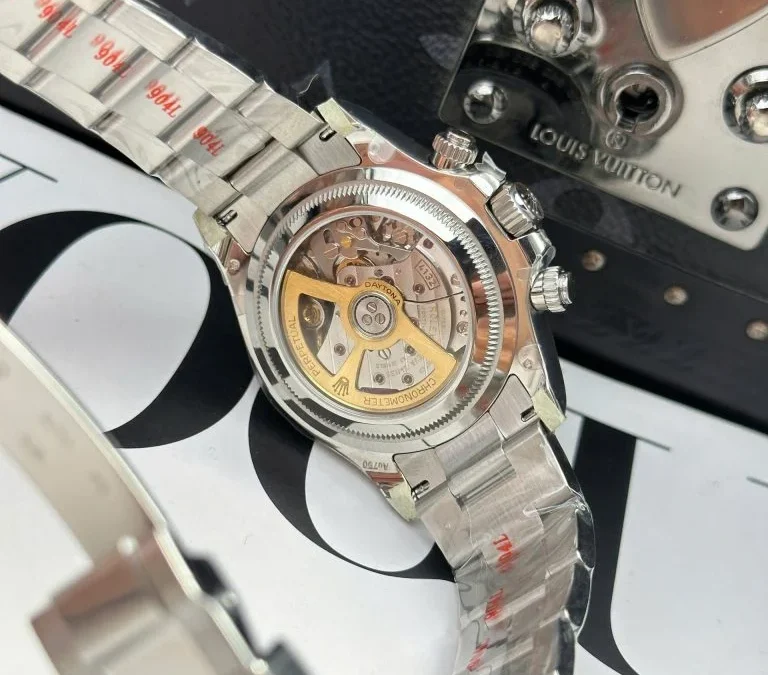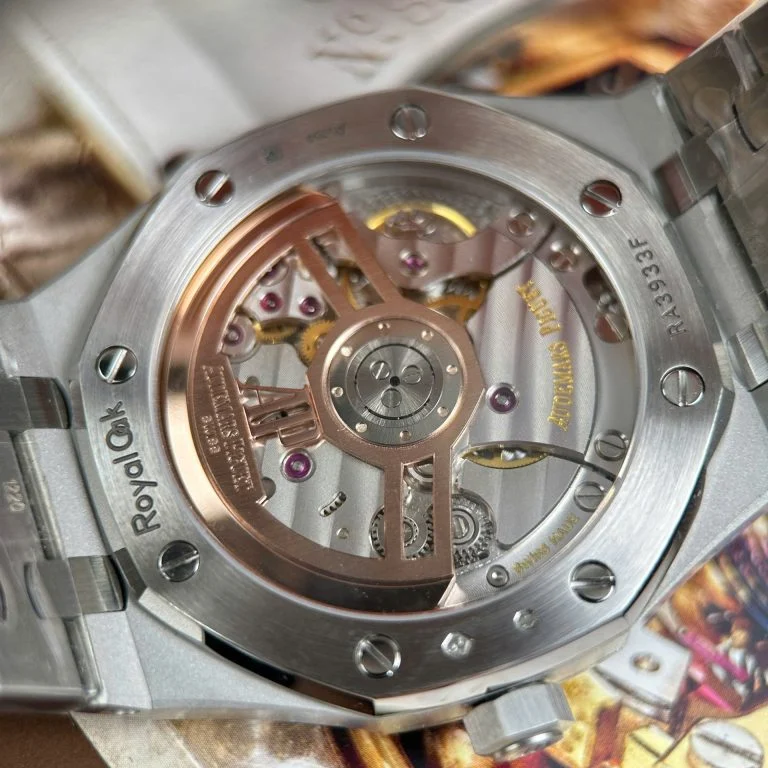If the face of a watch is its dial, then the movement is its heart, the engine that makes time tick with style and precision. It’s the hidden mechanism that converts energy into motion, brings the hands to life and powers every function from the ticking seconds to the sweeping chronograph.
Watch movements, or calibers, are works of art and engineering. Whether mechanical or quartz, every one tells a story of innovation and craftsmanship. Understanding these movements gives you a deeper appreciation for how watches really work beyond the design and brand.
From the rhythmic beat of a balance wheel to the steady vibration of a quartz crystal, every watch has its own rhythm. Let’s dive into the world of movements where technology, tradition, and human ingenuity come together to make time beautiful.
What Is a Watch Movement?
A watch movement, also known as a caliber, is the internal mechanism that powers every function of a timepiece. It’s responsible for moving the hands, changing the date, operating complications, and maintaining precision over time.
At its core, a movement performs three essential roles:
- Energy generation – storing and releasing power through a mainspring or battery.
- Time regulation – using a balance wheel or quartz crystal to maintain steady rhythm.
- Display drive – transmitting energy to move the hands and indicators accurately.
There are three main movement categories: manual mechanical, automatic mechanical, and quartz. Each type offers a distinctive experience, from the soulful winding of a manual watch to the scientific precision of a quartz oscillator.
| Type | Power Source | Accuracy | Maintenance | Appeal |
| Manual Mechanical | Hand-wound mainspring | ±10 sec/day | Regular winding | Classic & nostalgic |
| Automatic Mechanical | Wrist motion rotor | ±5 sec/day | Service every 3–5 yrs | Effortless & traditional |
| Quartz | Battery powered | ±15 sec/month | Battery change | Ultra-precise & convenient |
The Beauty of Mechanical Movements
- How Mechanical Movements Work
Mechanical movements are the oldest and most admired form of watchmaking. They run without batteries i.e., powered solely by a coiled mainspring. When the spring unwinds, it releases stored energy through a delicate series of gears called the gear train.
At the end of this train lies the escapement, which regulates how much energy escapes at a time, creating the signature ‘tick-tock’ rhythm. The balance wheel, oscillating back and forth, acts like a pendulum that controls the flow of energy.
This system transforms raw stored energy into precise, rhythmic motion. Moving the hands consistently and beautifully. The frequency, often 28,800 vibrations per hour (vph), determines the smoothness of the second hand’s sweep. Watching this micro-mechanical orchestra in action is what makes mechanical watches so captivating.
- Manual vs. Automatic Movements
Mechanical watches come in two main forms: manual and automatic.
- Manual watches require daily or periodic winding through the crown. This ritual connects the wearer directly with their watch, creating an intimate bond.
- Automatic watches feature a small rotor that winds the mainspring as the wearer moves. This self-sustaining mechanism combines convenience with the same mechanical soul.
Both types embody timeless watchmaking philosophy i.e., intricate, enduring, and alive through motion. For many enthusiasts, the choice between manual and automatic isn’t about convenience but personality: manual for tradition, automatic for balance and ease.
- Craftsmanship and Decoration
Beyond precision, mechanical movements are celebrated for artistry. Finishing techniques like Geneva stripes, perlage (circular graining), and anglage (chamfered edges) turn functional components into miniature works of art.
Watchmakers often showcase this beauty through exhibition casebacks, allowing wearers to admire the oscillating balance wheel and gleaming bridges. Luxury and independent brands alike invest countless hours perfecting these finishes, even on parts invisible to the naked eye.
The result is not just mechanical reliability but emotional resonance, a harmonious blend of art and engineering that continues to inspire watch enthusiasts worldwide.
| Component | Function | Craftsmanship Feature |
| Escapement | Regulates energy release | Precision-cut teeth |
| Balance wheel | Controls timing | Hand-adjusted regulation |
| Jewels | Minimize friction | Synthetic ruby bearings |
| Rotor (auto) | Winds mainspring | Engraved or skeletonized design |
Quartz Movements: Precision Meets Practicality
The arrival of quartz movements in the late 1960s marked one of horology’s greatest technological leaps. These timepieces harness the predictable vibrations of a quartz crystal i.e. 32,768 times per second, to achieve remarkable accuracy, often within a few seconds per month.
- How Quartz Movements Work
A small battery sends electrical current through the quartz crystal, causing it to oscillate consistently. A microchip counts these oscillations and drives a miniature step motor that turns the hands. This elegant blend of physics and electronics ensures unmatched reliability with minimal maintenance.
The steady “tick” of a quartz second hand is the result of each pulse powering a step in motion, a dance of energy translated into precision.
- Advantages of Quartz Watches
Quartz watches are known for:
- Superior accuracy – nearly unaffected by temperature or motion.
- Ease of maintenance – no winding or complex servicing needed.
- Affordability and durability – making them ideal for everyday wear.
| Feature | Mechanical | Quartz |
| Power Source | Mainspring | Battery |
| Accuracy | ±10 sec/day | ±15 sec/month |
| Maintenance | Service every few years | Battery every 1–2 years |
| Experience | Traditional craftsmanship | Scientific precision |
From timeless classics to cutting-edge designs, quartz movements democratized watch ownership and brought reliable precision to millions of wrists around the world.V. Hybrid and Smart Movements: Bridging Tradition and Innovation
Modern watchmaking thrives on innovation, and hybrid movements represent the best of both worlds. Timepieces like Seiko’s Spring Drive use a traditional mainspring for power but regulate it electronically for near-perfect accuracy. Others, such as Citizen’s Eco-Drive, convert light into energy, offering an eco-friendly, battery-free experience.
Kinetic and solar technologies have also transformed the landscape, proving that progress and tradition can coexist beautifully. Even hybrid analog-smart watches now feature Bluetooth connectivity, activity tracking, and notifications, all while retaining the classic look of an analog dial.
These advancements show how horology continues to evolve. Blending mechanical artistry with the convenience of modern science, ensuring the heartbeat of timekeeping stays strong in the digital age.
How Movement Type Shapes the Watch Experience
Each movement type offers a distinct personality and emotional connection:
- Mechanical watches evoke romance, craftsmanship, and the satisfying ritual of winding.
- Quartz watches provide precision, convenience, and reliability, perfect for modern professionals.
- Hybrid watches symbolize innovation and forward thinking.
The movement influences not only performance but also how a watch feels. A mechanical watch “breathes” with motion, a quartz piece reassures with accuracy, and a hybrid thrills with innovation.
There’s no single “best” movement; each speaks to a different lifestyle. The beauty of modern horology lies in this diversity: whether one seeks tradition, technology, or both, the right movement resonates personally, making each timepiece uniquely meaningful.
Caring for Your Watch Movement
Proper care ensures a watch movement’s longevity.
- Mechanical watches: Wind regularly, avoid strong magnets, and service every 3–5 years.
- Quartz watches: Replace batteries promptly to prevent leakage.
- All watches: Clean gently with a soft cloth, store away from moisture, and use protective cases during travel.
A well-maintained movement can last decades, even generations, preserving both accuracy and emotional value. Regular attention keeps the heartbeat of your timepiece strong and steady.
Conclusion
Watch movements are more than mechanisms. They’re the soul of timekeeping. From the poetry of mechanical gears to the precision of quartz vibrations and the innovation of hybrid calibers, every movement tells a story of human ingenuity.
To understand a movement is to appreciate the living art inside a watch, the heartbeat that never stops. Whether you’re winding a classic or admiring a quartz masterpiece, you’re connecting with centuries of craftsmanship distilled into a single, timeless rhythm.
Explore premium super clone watches that capture this artistry at SuperLuxuryReps.com—where every movement is built to perfectio


